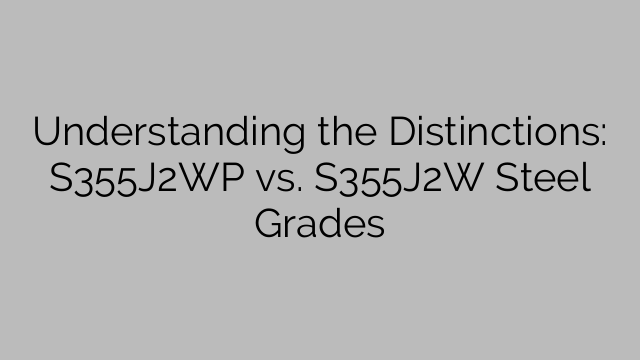Understanding the Distinctions: S355J2WP vs. S355J2W Steel Grades
When it comes to steel, there are numerous grades available, each with specific properties and applications. Two such grades that often get confused are S355J2WP and S355J2W. While they sound similar, they have distinct differences that need to be understood before selecting the appropriate grade for a particular project.
S355J2WP and S355J2W are both weathering steel grades, designed to offer enhanced corrosion resistance compared to standard carbon steel. Weathering steels, also known as atmospheric corrosion-resistant steels, form a protective rust-like layer on their surface when exposed to the elements. This layer acts as a barrier, preventing further corrosion and allowing the steel to withstand outdoor conditions without the need for additional coatings.
The main difference between S355J2WP and S355J2W lies in their chemical composition, specifically the addition of certain elements that promote the formation of the protective rust layer. S355J2WP contains higher levels of Phosphorus, Copper, Chromium, Nickel, and Molybdenum compared to S355J2W. These elements not only enhance corrosion resistance but also provide improved mechanical properties, such as higher tensile and yield strength.
Due to its increased alloying elements, S355J2WP is generally recommended for use in more aggressive atmospheric environments, such as coastal areas with high salt content in the air or industrial areas with chemical pollutants. It is often used in structural applications, such as bridges, tanks, and containers, where long-term durability is crucial.
On the other hand, S355J2W is a less alloyed grade, which makes it more cost-effective and easier to process. It is suitable for use in less demanding atmospheric conditions, such as rural or urban environments, where the exposure to corrosive elements is moderate. S355J2W is commonly used in applications like facades, architectural structures, and decorative elements, where aesthetics play an important role.
Both S355J2WP and S355J2W offer excellent weldability, formability, and machinability, making them versatile choices for various steel fabrication processes. They can be shaped and cut into desired forms while retaining their corrosion-resistant properties.
When choosing between these two grades, it is essential to carefully assess the environmental conditions and performance requirements of the specific project. Factors like proximity to the coast, pollution levels, and the structure’s purpose should be considered to select the most appropriate grade. Consulting with steel experts or metallurgists can provide valuable guidance in making the correct choice.
In conclusion, S355J2WP and S355J2W are weathering steel grades that differ mainly in their chemical composition, which affects their corrosion resistance and mechanical properties. S355J2WP is recommended for more severe atmospheric conditions, while S355J2W suits less aggressive environments. Understanding these distinctions allows engineers and architects to make informed decisions and ensure long-lasting, durable structures.

